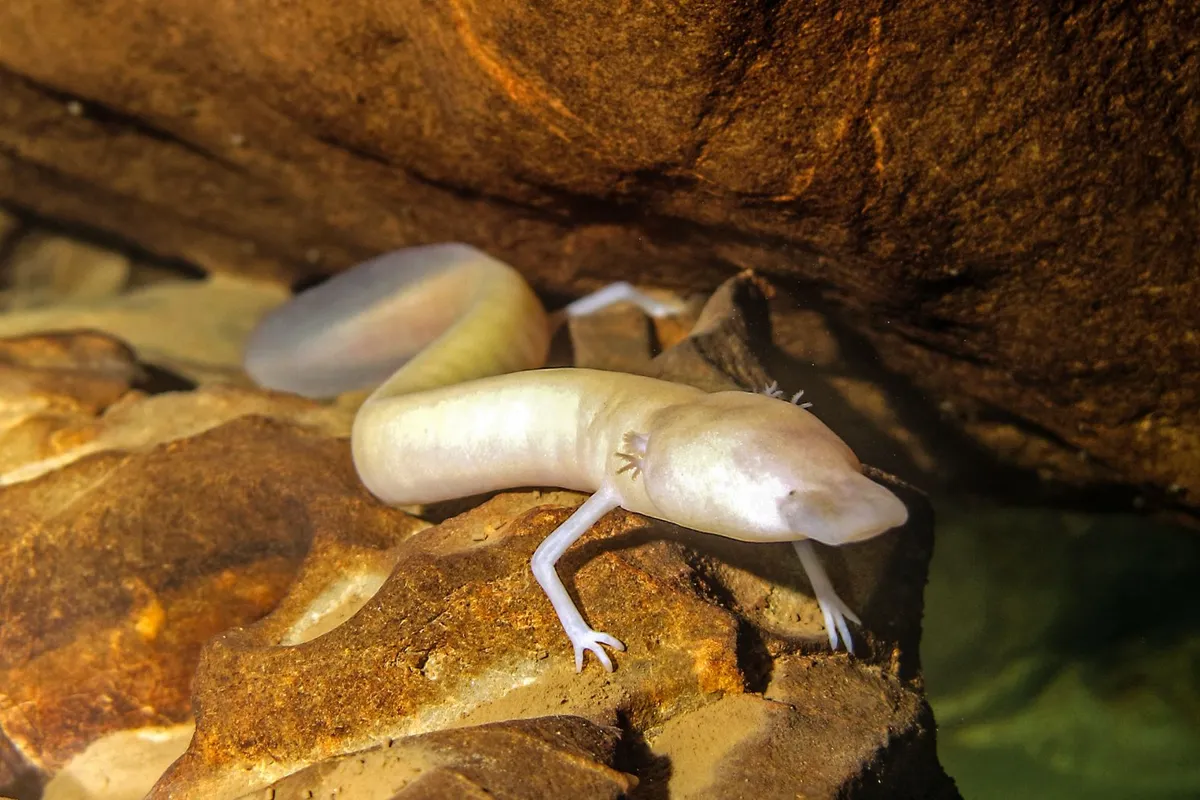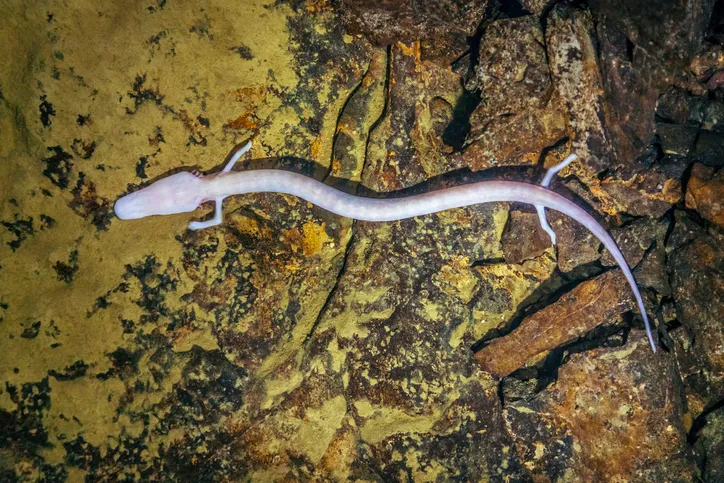Olms, cave-dwelling salamanders, have been surrounded by mystery for centuries. Local people often saw the olms after heavy rains washed them from the caves, and believed they were the offspring of 'cave dragons'.
With the olm's sinuous body and external gills, it’s not too difficult to understand this particular case of mistaken identity.

How big are olms?
Olms are about a foot long (12 inches or 30cm) and are one of the weirdest animals in the world
What do olms look like?
Unlike the majority of amphibians, the olm is completely aquatic, and like all troglobites (true cave-dwelling creatures), it is adapted to living its whole life in the darkness of caves. It lacks any pigmentation in its skin, resulting in it being a pink or yellow-white colour. This led to it being described as a ‘human fish’ by locals, due to the similarity of its coloration to their own skin colour.
- Weirdest fish: 12 of the strangest fish in the world
- 15 weirdest animals: meet the weird freaks and oddballs of the natural world
- 10 Ice Age animals: meet the extraordinary beasts that thrived when the world was frozen
Do olms have eyes?
Skin pigmentation isn’t the only thing the olm lacks. Its eyes are severely undeveloped and, in fact, after a few months of development during its larval stage, its eyes begin to atrophy (wither away). It does retain a small amount of photosensitivity, but why bother growing eyes at all if they aren’t going to be used for subterranean hunting? Instead, priority is given to its other senses.
" Olms are cave-dwelling salamanders that have been surrounded by mystery for centuries."
How do olms find their prey if they are blind?
The olm has enhanced mechanosensory and chemosensory abilities. “Hearing is essentially mechanosensory – picking up vibrations or sounds caused by the motion of prey,” says Professor Geoff Boxshall, a zoologist at the Natural History Museum in London. “Similarly, for chemosensory abilities – it would be important for a scavenger locating decaying bodies, as there would be a good source of chemicals diffusing out of them, and the scavenger could home in on that.”
However, the olm also has an extra sense – the remarkable ability to sense the bioelectric field of other organisms. “All animals produce a weak bioelectric field from nerve impulses, muscle contractions, and so on,” continues Boxshall. “The olm is able to sense when its own bioelectric field is disturbed by an interaction with the field of an approaching creature, such as a shrimp, and can then catch its prey.”

Caves are low-energy systems, with no light and thus no plants nor photosynthesis. Cave food-webs are reliant on nutrients flowing into the cave from outside. The unreliability of such systems means that patience is the key for a cave’s residents.
The olm is an ambush predator, lurking silently and completely still, waiting for some unknowing creature to enter its bioelectric field.
What do olms eat?
During times of plenty, the olm is able to consume considerable amounts of prey and lay down reserves in its liver, to tide it over when food is scarce. Research has shown that, in extreme cases, olms can survive for a decade without feeding. If food is scarce, an olm will reduce its activity and lower its metabolic rate. In severe cases, it can even reabsorb its own tissue for nutrients.
"The olm is an ambush predator, lurking silently and completely still, waiting for some unknowing creature to enter its bioelectric field."
How long do olms live?
The olm develops relatively slowly and scientists don’t actually know how long it lives. One captive olm was recorded as being at least 58 years old, but there are some estimates that olms could live to be 100 – there's still much to be discovered about this elusive species.
- Is there really no such thing as a fish?
- Deadliest apex predators in the wild: which mammals are the best killing machines?
- Apex predators: What they are, why they're important and how apex predators affect ecosystems
What is a black olm?
The olm is renowned for being a pale creature lacking skin pigmentation. However, not all olms are the same. In fact, there is one recognised subspecies, Proteus anguinus parkelj, the black olm, which can be dark brown as well as black. Discovered in 1986, the black olm is restricted to an area smaller than 100sq km near Crnomelj in Slovenia.
As well as having pigmentation, the black olm has a number of other differences to the nominate subspecies (P. a. anguinus). Its head is slightly shorter, with strong jaw muscles, and it has shorter legs. Though its body length is slightly longer (it has 34–35 vertebrae compared to 29–32 in the nominate subspecies), its tail is shorter, in proportion.
In addition, rather than having completely regressed eyes, the eyes of the black olm develop almost normally, and have principal rods, and both red-sensitive and blue-sensitive cones.
- What's the largest amphibian?
- Chytridiomycosis guide: what it is and why it's endangering amphibians
Megan Shersby visited Postojna Caves with the Slovenian Tourist Board: www.slovenia.info to see the olms

